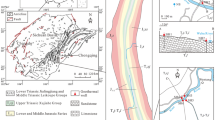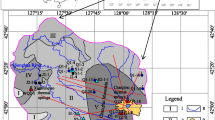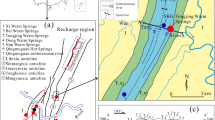Abstract
Thermal groundwater occurs in bedrock aquifers consisting of the dolomite of the Wumishan Group of the Jixianin System and the Cambrian carbonate in the Xiaotangshan geothermal field near the northern margin of the North China Plain, China. The hot water in the geothermal field of basin-type discharges partly in the form of the Xiaotangshan hot spring under natural conditions. The hot water has TDS of less than 600 mg/L and is of Na·Ca-HCO3 type. The geothermal water receives recharge from precipitation in the mountain area with elevation of about 500 m above sea level to the north of the spring. Thermal groundwater flows slowly south and southeast through a deep circulation with a residence time of 224 years estimated with the Ra–Rn method. The Xiaotangshan hot spring dried up in the middle of the 1980s owing to the increasing withdrawal of the hot water in the geothermal field in the past decades. The water level of the geothermal system still falls continually at an annual average rate of about 2 m, although water temperature changes very little, indicating that the recharge of such a geothermal system of basin-type is limited. Over-exploitation has a dramatic impact on the geothermal system, and reduction in exploitation and reinjection are required for the sustainable usage of the hot water.







Similar content being viewed by others
References
Beijing Party of the Bureau of Hydrogeology and Engineering Geology of the Ministry of Geology of China (1958) Hydrogeological investigation report of the Xiaotangshan mineral spring, Changping, pp 54
Chen Z (1993) An analysis of the long-time stability of the Xiaotangshan geothermal field under exploitation using a method of hydrogen and oxygen isotopes. In: Proceedings of the second national symposium on isotopic hydrogeology: advances in isotopic hydrogeology in China. Press of Tianjin University, pp 63–67
Cherdyntsev VV (Translated from Russian by Schmorak J) (1971) Uranium-234, Keter Press, Jerusalem, pp 234
Craig H (1961) Isotopic variations in meteoric waters. Science l33:1702–1703
Dilsiz C (2006) Conceptual hydrodynamic model of the Pamukkale hydrothermal field, southwestern Turkey, based on hydrochemical and isotopic data. Hydrogeol J 14(4):562–572
Fournier RO (1977) Chemical geothermometers and mixing models for geothermal systems. Geothermics 5(1–4):41–50
Geophysical and Geochemical Investigation Team of Beijing Bureau of Geology and Mineral Resources (1987) Report of regional investigation of electromotive depth in the plain area of Beijing (1/50000)
Giggenbach WF (1988) Geothermal solute equilibrium, derivation of Na-K-Mg-Ca geoindicators. Geochim Cosmochim Acta 52(12):2749–2765
Hu S, Lu J, Zhu G (1992) Famous springs in China. Geological Publishing House, Beijing
Huang S, Feng J, Zheng K, Xie C, Ma D (1989) Characteristics of hydrogen and oxygen isotopes of waters in Beijing geothermal field and vicinity. In: Institute of Geodynamics of China Academy of Geological Science (eds) Geothermal Special Issue (2). Geological Publishing House, pp 155–162
Li Z (1994) History of geothermal exploitation and utilization in Beijing. J Hebei Coll Geol 17(3):271–284
Liu J (2003) A study of geothermal reinjection of low-enthalpy resources. A Doctoral Dissertation of China University of Geosciences-Beijing, pp 82
Liu CL, Che YT, Lu JB (2006) Influence of Jingbei geothermal field exploitation on subsurface fluid behaviors. Seismol Geol 28(1):142–149
Pan X, Wang Z (1999) The characteristics of the thermal water in the Xiaotangshan geothermal field. Beijing (4):7–15
Sorey ML, Colvard EM (1997) Hydrologic investigations in the Mammoth Corridor, Yellowstone National Park and vicinity, USA. Geothermics 26(2):221-249
Sun Z, Li X, Shi W (1992) Hydrogeochemistry of thermal groundwater of low-to-moderate temperature in Jiangxi. J East China Coll Geol 15(3):243–248
Wang H (1991) Isotopes in hydrogeology. Geological Publishing House, Beijing
Wang J, Pang Z, Xiong L, Wang J, Jiang Z, Chen G, Zhuang Q (1991) Analyses of formation of the thermal-water system in the Zhangzhou Basin. In: Ren X, Tang N, Liu S, Bai T (eds) Proceedings of the third national symposium on geothermal resources. Beijing Science and Technology Press, pp 116–122
Wei K, Lin R, Wang Z (1982) Deuterium and oxygen-18 concentrations in the rain of Beijing. Science in China-Series B (8):754–757
Xie C, An K, Tang C (1959) Mineral water in the eastern part of Hebei Province. In: (eds) Institute of Hydrogeology and Engineering Geology of the Ministry of Geology of China Paper Collections of Hydrogeology and Engineering Geology. Geological Publishing House, pp 133–171
Xu X (1989) Geothermal and geologic conditions in the Xiaotangshan geothermal field in Beijing. In: (eds) Institute of Geodynamics of China Academy of Geological Science Geothermal Special Issue (2). Geological Publishing House, pp 148–154
Zheng K, Ma D, Xie C, Huang S, Feng J, Wu J (1989) A primary analysis of the isotopes of thermal groundwater in the Beijing geothermal field. In: (eds) Institute of Geodynamics of China Academy of Geological Sceince Geothermal Special Issue (2). Geological Publishing House, pp 163–170
Zeng R, Wang Z, Zhang J, Wang D, Tang X, Ye S (2002) A study of the relationship between water level and exploitation in the Xiaotangshan geothermal field, Beijing. In: Liu J, Zheng K, Liu S, Bin D (eds) Proceedings of 2002 Beijing international geothermal symposium. Geological Publishing House, pp 228–232
Zhou H, Zhou X, Fang B, Li J, Liu C (2006a) Hot springs in Beijing and its northwestern neighboring area. City Geol 1(1):9–15
Zhou X, Zhou H, Fang B, Fan Y, Li J, Wang X (2006b) Evolution of thermal groundwater resources under the conditions of exploitation: A preliminary analysis. Geol Bull China 25(4):482–486
Acknowledgments
This work was cooperatively supported by the Construction Plan for the Co-Construction Subjects from the Education Committee of Beijing (JD104910555), the Natural Science Foundation of Beijing (8042019) and the Natural Science Foundation of China (40572147).
Author information
Authors and Affiliations
Corresponding author
Rights and permissions
About this article
Cite this article
Haiyan, Z., Xun, Z., Rui, C. et al. Occurrence and evolution of the Xiaotangshan hot spring in Beijing, China. Environ Geol 53, 1483–1489 (2008). https://doi.org/10.1007/s00254-007-0757-z
Received:
Accepted:
Published:
Issue Date:
DOI: https://doi.org/10.1007/s00254-007-0757-z




